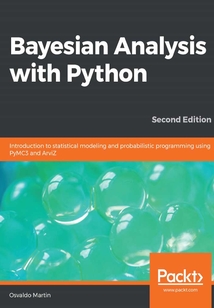舉報 

會員
Bayesian Analysis with Python
ThesecondeditionofBayesianAnalysiswithPythonisanintroductiontothemainconceptsofappliedBayesianinferenceanditspracticalimplementationinPythonusingPyMC3,astate-of-the-artprobabilisticprogramminglibrary,andArviZ,anewlibraryforexploratoryanalysisofBayesianmodels.ThemainconceptsofBayesianstatisticsarecoveredusingapracticalandcomputationalapproach.Syntheticandrealdatasetsareusedtointroduceseveraltypesofmodels,suchasgeneralizedlinearmodelsforregressionandclassification,mixturemodels,hierarchicalmodels,andGaussianprocesses,amongothers.Bytheendofthebook,youwillhaveaworkingknowledgeofprobabilisticmodelingandyouwillbeabletodesignandimplementBayesianmodelsforyourowndatascienceproblems.Afterreadingthebookyouwillbebetterpreparedtodelveintomoreadvancedmaterialorspecializedstatisticalmodelingifyouneedto.
目錄(198章)
倒序
- coverpage
- Title Page
- Copyright and Credits
- Bayesian Analysis with Python Second Edition
- Dedication
- About Packt
- Why subscribe?
- Packt.com
- Foreword
- Contributors
- About the author
- About the reviewer
- Packt is searching for authors like you
- Preface
- Who this book is for
- What this book covers
- To get the most out of this book
- Download the example code files
- Download the color images
- Conventions used
- Get in touch
- Reviews
- Thinking Probabilistically
- Statistics models and this book's approach
- Working with data
- Bayesian modeling
- Probability theory
- Interpreting probabilities
- Defining probabilities
- Probability distributions
- Independently and identically distributed variables
- Bayes' theorem
- Single-parameter inference
- The coin-flipping problem
- The general model
- Choosing the likelihood
- Choosing the prior
- Getting the posterior
- Computing and plotting the posterior
- The influence of the prior and how to choose one
- Communicating a Bayesian analysis
- Model notation and visualization
- Summarizing the posterior
- Highest-posterior density
- Posterior predictive checks
- Summary
- Exercises
- Programming Probabilistically
- Probabilistic programming
- PyMC3 primer
- Flipping coins the PyMC3 way
- Model specification
- Pushing the inference button
- Summarizing the posterior
- Posterior-based decisions
- ROPE
- Loss functions
- Gaussians all the way down
- Gaussian inferences
- Robust inferences
- Student's t-distribution
- Groups comparison
- Cohen's d
- Probability of superiority
- The tips dataset
- Hierarchical models
- Shrinkage
- One more example
- Summary
- Exercises
- Modeling with Linear Regression
- Simple linear regression
- The machine learning connection
- The core of the linear regression models
- Linear models and high autocorrelation
- Modifying the data before running
- Interpreting and visualizing the posterior
- Pearson correlation coefficient
- Pearson coefficient from a multivariate Gaussian
- Robust linear regression
- Hierarchical linear regression
- Correlation causation and the messiness of life
- Polynomial regression
- Interpreting the parameters of a polynomial regression
- Polynomial regression – the ultimate model?
- Multiple linear regression
- Confounding variables and redundant variables
- Multicollinearity or when the correlation is too high
- Masking effect variables
- Adding interactions
- Variable variance
- Summary
- Exercises
- Generalizing Linear Models
- Generalized linear models
- Logistic regression
- The logistic model
- The Iris dataset
- The logistic model applied to the iris dataset
- Multiple logistic regression
- The boundary decision
- Implementing the model
- Interpreting the coefficients of a logistic regression
- Dealing with correlated variables
- Dealing with unbalanced classes
- Softmax regression
- Discriminative and generative models
- Poisson regression
- Poisson distribution
- The zero-inflated Poisson model
- Poisson regression and ZIP regression
- Robust logistic regression
- The GLM module
- Summary
- Exercises
- Model Comparison
- Posterior predictive checks
- Occam's razor – simplicity and accuracy
- Too many parameters leads to overfitting
- Too few parameters leads to underfitting
- The balance between simplicity and accuracy
- Predictive accuracy measures
- Cross-validation
- Information criteria
- Log-likelihood and deviance
- Akaike information criterion
- Widely applicable Information Criterion
- Pareto smoothed importance sampling leave-one-out cross-validation
- Other Information Criteria
- Model comparison with PyMC3
- A note on the reliability of WAIC and LOO computations
- Model averaging
- Bayes factors
- Some remarks
- Computing Bayes factors
- Common problems when computing Bayes factors
- Using Sequential Monte Carlo to compute Bayes factors
- Bayes factors and Information Criteria
- Regularizing priors
- WAIC in depth
- Entropy
- Kullback-Leibler divergence
- Summary
- Exercises
- Mixture Models
- Mixture models
- Finite mixture models
- The categorical distribution
- The Dirichlet distribution
- Non-identifiability of mixture models
- How to choose K
- Mixture models and clustering
- Non-finite mixture model
- Dirichlet process
- Continuous mixtures
- Beta-binomial and negative binomial
- The Student's t-distribution
- Summary
- Exercises
- Gaussian Processes
- Linear models and non-linear data
- Modeling functions
- Multivariate Gaussians and functions
- Covariance functions and kernels
- Gaussian processes
- Gaussian process regression
- Regression with spatial autocorrelation
- Gaussian process classification
- Cox processes
- The coal-mining disasters
- The redwood dataset
- Summary
- Exercises
- Inference Engines
- Inference engines
- Non-Markovian methods
- Grid computing
- Quadratic method
- Variational methods
- Automatic differentiation variational inference
- Markovian methods
- Monte Carlo
- Markov chain
- Metropolis-Hastings
- Hamiltonian Monte Carlo
- Sequential Monte Carlo
- Diagnosing the samples
- Convergence
- Monte Carlo error
- Autocorrelation
- Effective sample sizes
- Divergences
- Non-centered parameterization
- Summary
- Exercises
- Where To Go Next?
- Other Books You May Enjoy
- Leave a review - let other readers know what you think 更新時間:2021-08-20 10:14:06
推薦閱讀
- Dreamweaver CS3 Ajax網頁設計入門與實例詳解
- Project 2007項目管理實用詳解
- 大數據戰爭:人工智能時代不能不說的事
- 輕輕松松自動化測試
- 錯覺:AI 如何通過數據挖掘誤導我們
- Java實用組件集
- Getting Started with Oracle SOA B2B Integration:A Hands-On Tutorial
- 計算機原理
- 返璞歸真:UNIX技術內幕
- 機艙監測與主機遙控
- Ruby on Rails敏捷開發最佳實踐
- 簡明學中文版Photoshop
- MPC5554/5553微處理器揭秘
- 計算智能算法及其生產調度應用
- Hadoop Beginner's Guide
- 設計模式
- 工業機器人應用系統三維建模
- 工廠電氣控制設備
- 系統建模與控制導論
- 單片機原理、接口及應用系統設計
- Python Data Mining Quick Start Guide
- Photoshop CS6婚紗數碼照片處理達人秘笈
- 搞定J2EE核心技術與企業應用
- DevOps for Salesforce
- 機器學習案例實戰
- 存儲技術原理分析
- 數據庫系統管理實務
- 學會提問,駕馭AI:提示詞從入門到精通
- 叩響智能制造的大門(全5冊)
- 傳感器原理及應用技術

